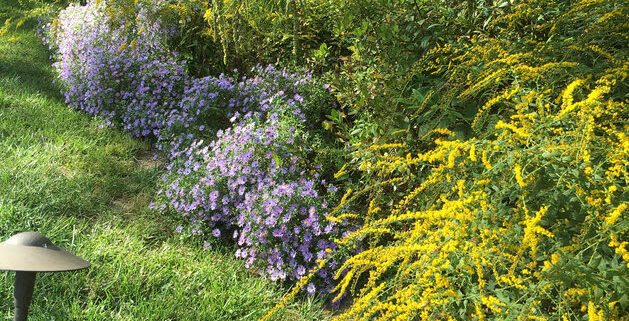Using native plants to deal with drought (and deluges)
Margaret Fisher
Neither droughts nor deluges are new to Northern Virginia, but as everyone has noticed, weather extremes are becoming more common. The prolonged drought this year that followed a wet 2018 was particularly hard on plants, as roots that have been weakened by too much water and accompanying fungi are more vulnerable the following year. When choosing which species to plant, we need to keep in mind the likelihood of these stressors repeating themselves in the future.
People living in the western part of the United States are more used to xeriscaping – planting for a dry environment – than those of us on the east coast. Lawns in California are being converted to native plantings at a rapid rate. But Virginians have been lulled by plentiful rainfall into settling for empty expanses of turf grass as the default landscaping choice, and those lawns start to look pretty peaked after weeks of drought. Fortunately, most native Virginia plants that have been installed in appropriate conditions held up quite well during our recent long dry spell. The gorgeous asters and goldenrods that define our fall landscape were no less beautiful this year. Having evolved here, they are used to both wet and dry summers. The exceptions tended to be plant species that have been experiencing ongoing stresses from disease, such as the Flowering Dogwood, and new plantings – all plants need appropriate amounts of water until they get established. By “appropriate,” we mean “not too much!” After the first few days, rainfall may indeed provide all that is needed during a wet spell, and supplying so much water that the plant never dries out is a good way to kill many native plants.
Determining which plants can withstand drought is not entirely straightforward. For instance, some of the best trees for dry, compacted soil are ones such as Baldcypress that normally live in swamps. They tolerate standing water not so much because they need the extra moisture but because they can deal with conditions of low oxygen. One way to quickly assemble a list of drought-tolerant plants is to look at recommendations for rain gardens. Rain gardens are designed to hold water for a couple days after a storm but then to absorb the water into the soil, leaving the plants dry in between. Another good reference is the plant lists for professionals page on the Plant NOVA Natives website. The plants in bold have been curated to include those that are particularly reliable as well as widely available, with detailed notations about their cultural needs.
Are you puzzling over where to install native plants instead of turf grass? Start where it is difficult or dangerous to mow, or where grass is growing poorly already. Or simply plop some shade trees in the middle of your lawn. In time, the summer temperatures in your yard will be noticeably lower.




